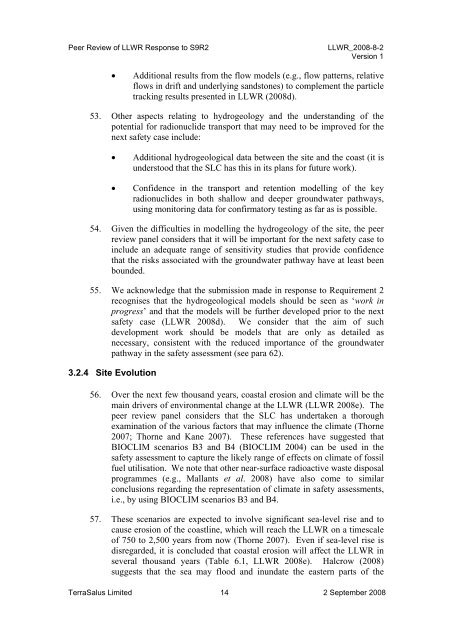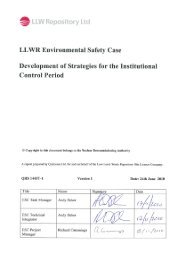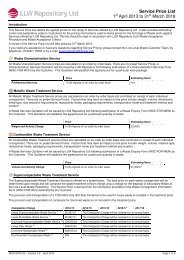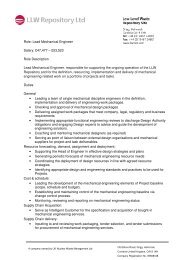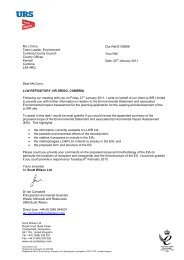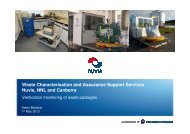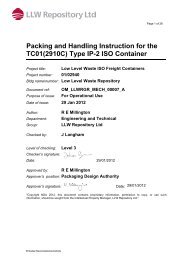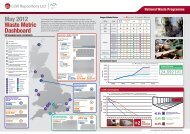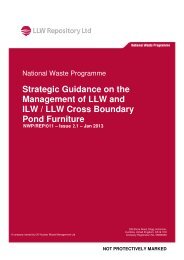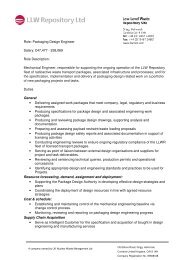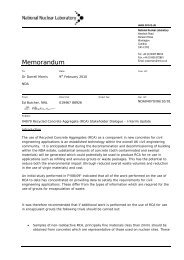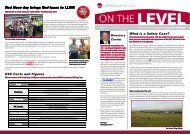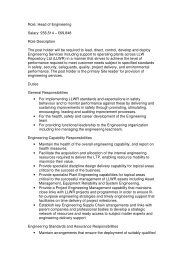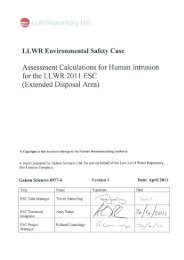Independent Peer Review of - Low Level Waste Repository Ltd
Independent Peer Review of - Low Level Waste Repository Ltd
Independent Peer Review of - Low Level Waste Repository Ltd
You also want an ePaper? Increase the reach of your titles
YUMPU automatically turns print PDFs into web optimized ePapers that Google loves.
<strong>Peer</strong> <strong>Review</strong> <strong>of</strong> LLWR Response to S9R2LLWR_2008-8-2Version 1Additional results from the flow models (e.g., flow patterns, relativeflows in drift and underlying sandstones) to complement the particletracking results presented in LLWR (2008d).53. Other aspects relating to hydrogeology and the understanding <strong>of</strong> thepotential for radionuclide transport that may need to be improved for thenext safety case include:Additional hydrogeological data between the site and the coast (it isunderstood that the SLC has this in its plans for future work).Confidence in the transport and retention modelling <strong>of</strong> the keyradionuclides in both shallow and deeper groundwater pathways,using monitoring data for confirmatory testing as far as is possible.54. Given the difficulties in modelling the hydrogeology <strong>of</strong> the site, the peerreview panel considers that it will be important for the next safety case toinclude an adequate range <strong>of</strong> sensitivity studies that provide confidencethat the risks associated with the groundwater pathway have at least beenbounded.55. We acknowledge that the submission made in response to Requirement 2recognises that the hydrogeological models should be seen as ‘work inprogress’ and that the models will be further developed prior to the nextsafety case (LLWR 2008d). We consider that the aim <strong>of</strong> suchdevelopment work should be models that are only as detailed asnecessary, consistent with the reduced importance <strong>of</strong> the groundwaterpathway in the safety assessment (see para 62).3.2.4 Site Evolution56. Over the next few thousand years, coastal erosion and climate will be themain drivers <strong>of</strong> environmental change at the LLWR (LLWR 2008e). Thepeer review panel considers that the SLC has undertaken a thoroughexamination <strong>of</strong> the various factors that may influence the climate (Thorne2007; Thorne and Kane 2007). These references have suggested thatBIOCLIM scenarios B3 and B4 (BIOCLIM 2004) can be used in thesafety assessment to capture the likely range <strong>of</strong> effects on climate <strong>of</strong> fossilfuel utilisation. We note that other near-surface radioactive waste disposalprogrammes (e.g., Mallants et al. 2008) have also come to similarconclusions regarding the representation <strong>of</strong> climate in safety assessments,i.e., by using BIOCLIM scenarios B3 and B4.57. These scenarios are expected to involve significant sea-level rise and tocause erosion <strong>of</strong> the coastline, which will reach the LLWR on a timescale<strong>of</strong> 750 to 2,500 years from now (Thorne 2007). Even if sea-level rise isdisregarded, it is concluded that coastal erosion will affect the LLWR inseveral thousand years (Table 6.1, LLWR 2008e). Halcrow (2008)suggests that the sea may flood and inundate the eastern parts <strong>of</strong> theTerraSalus Limited 14 2 September 2008


